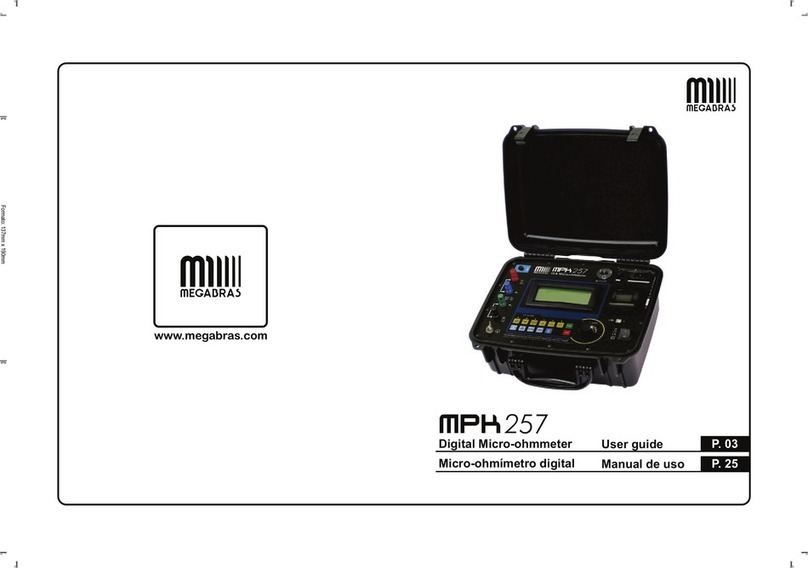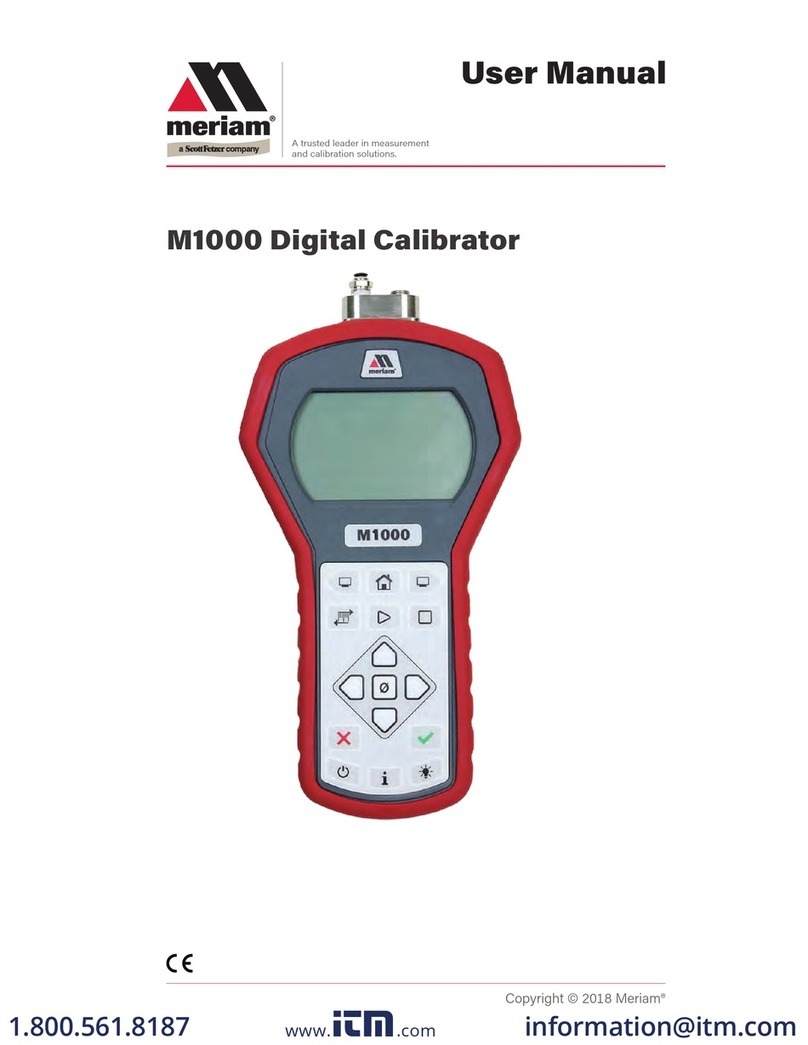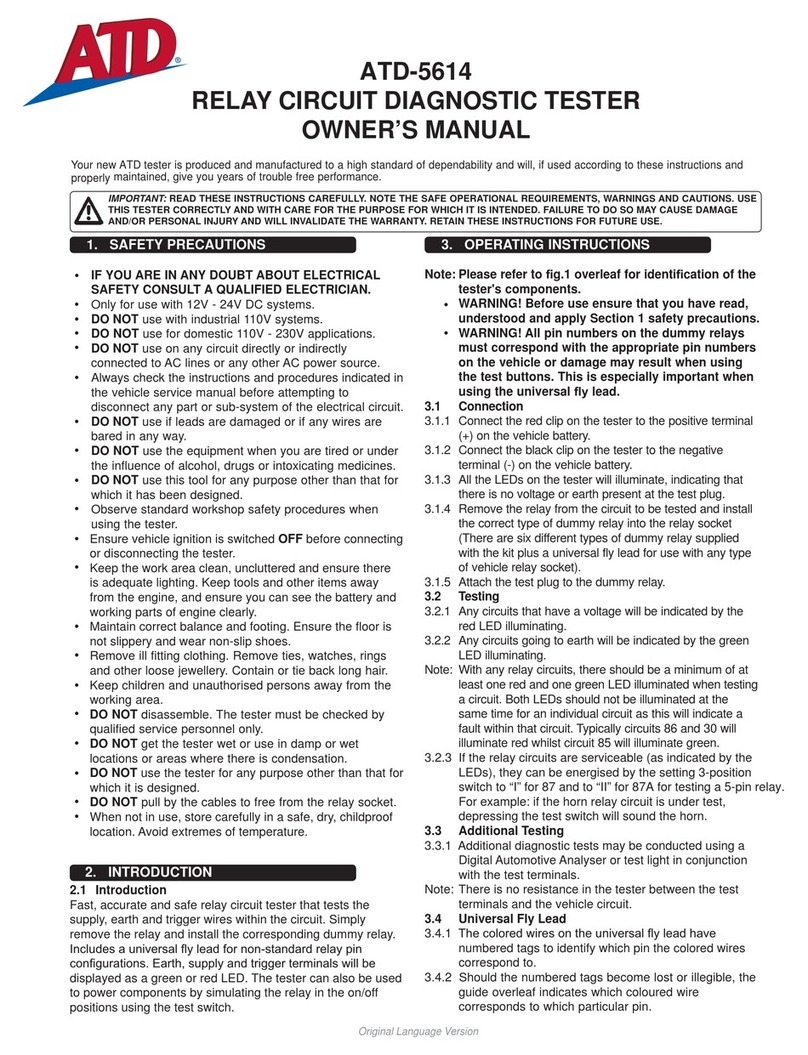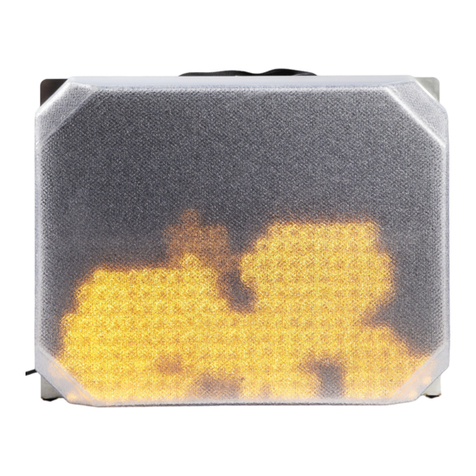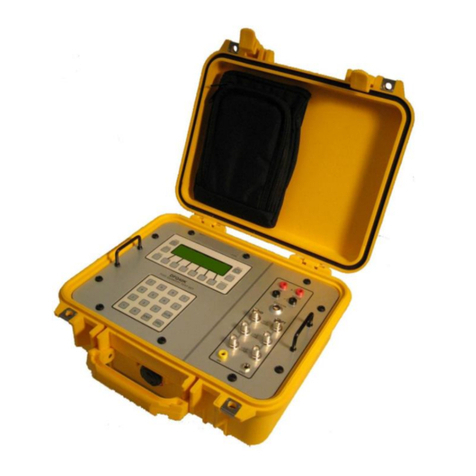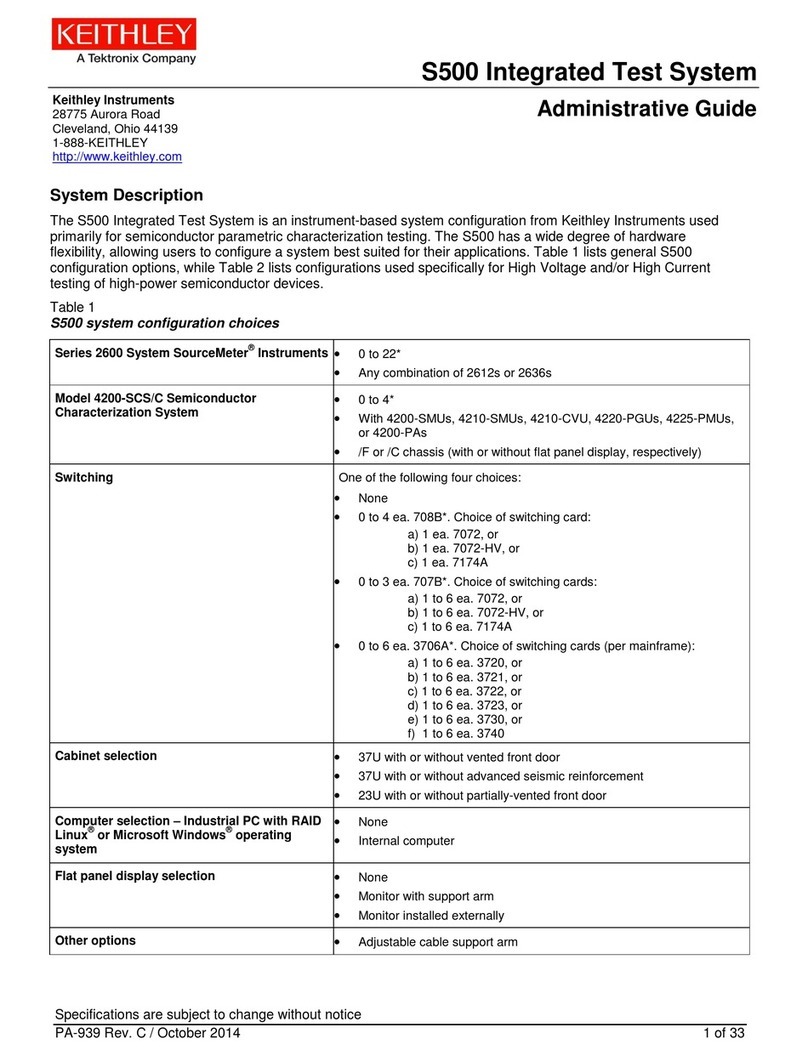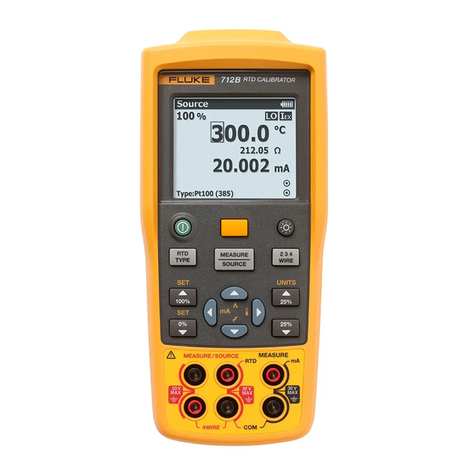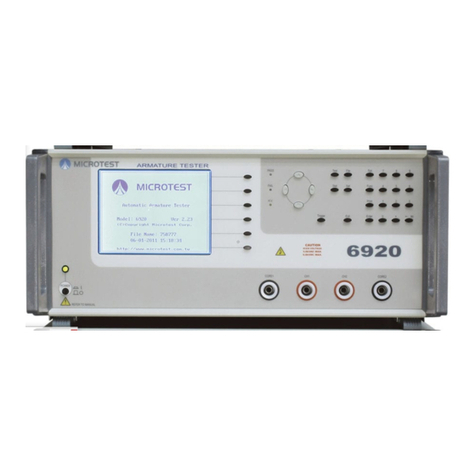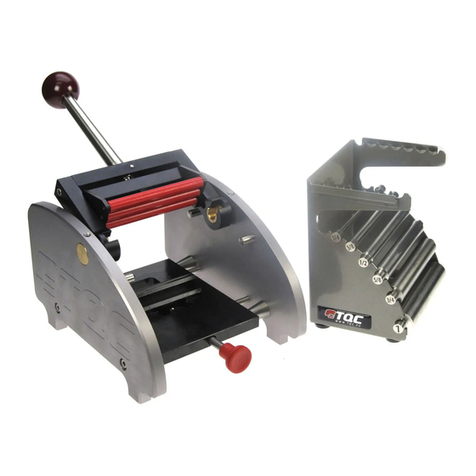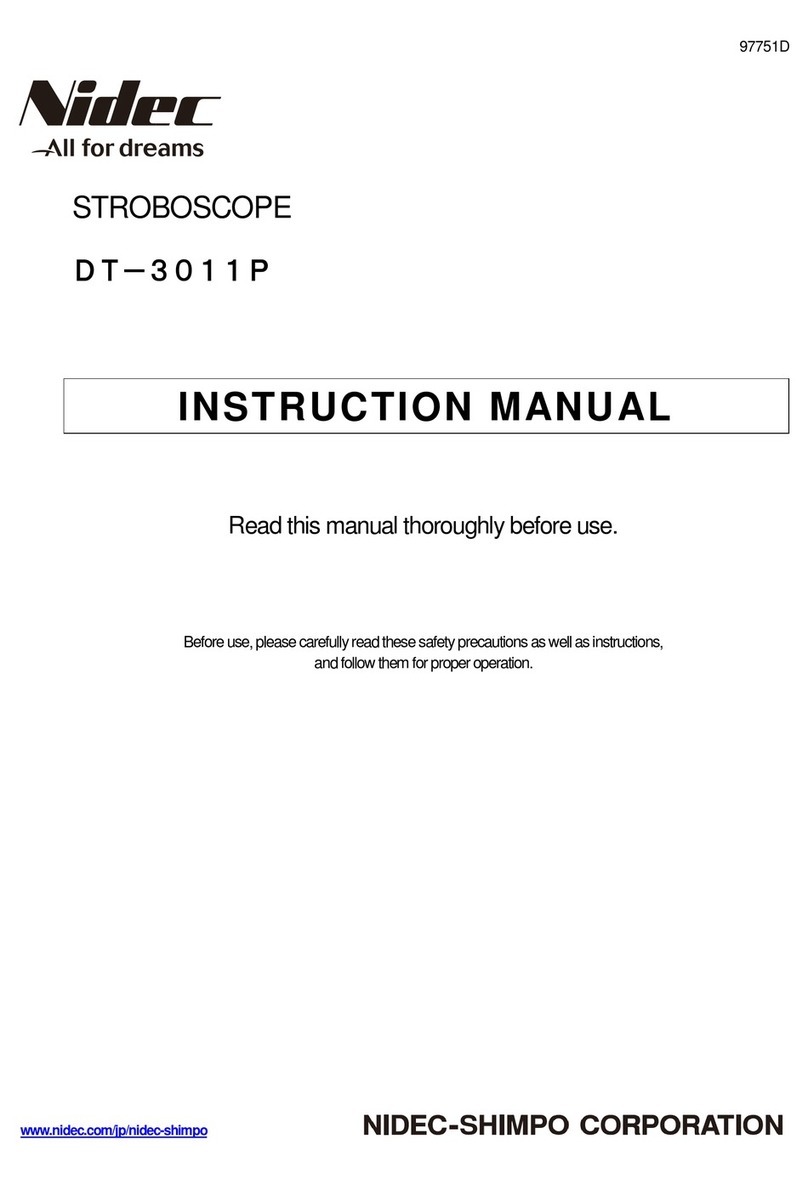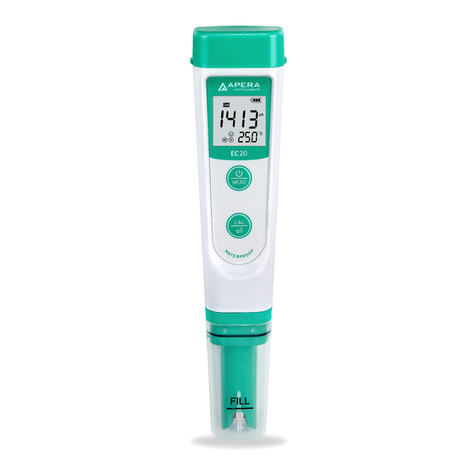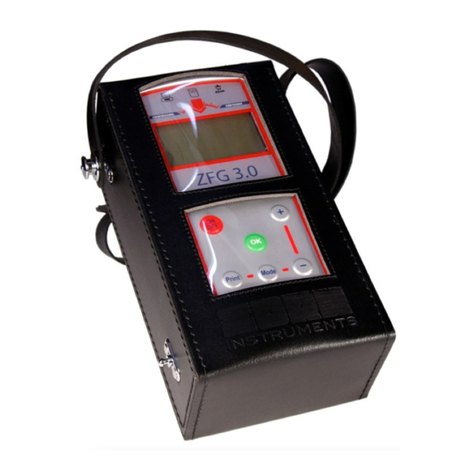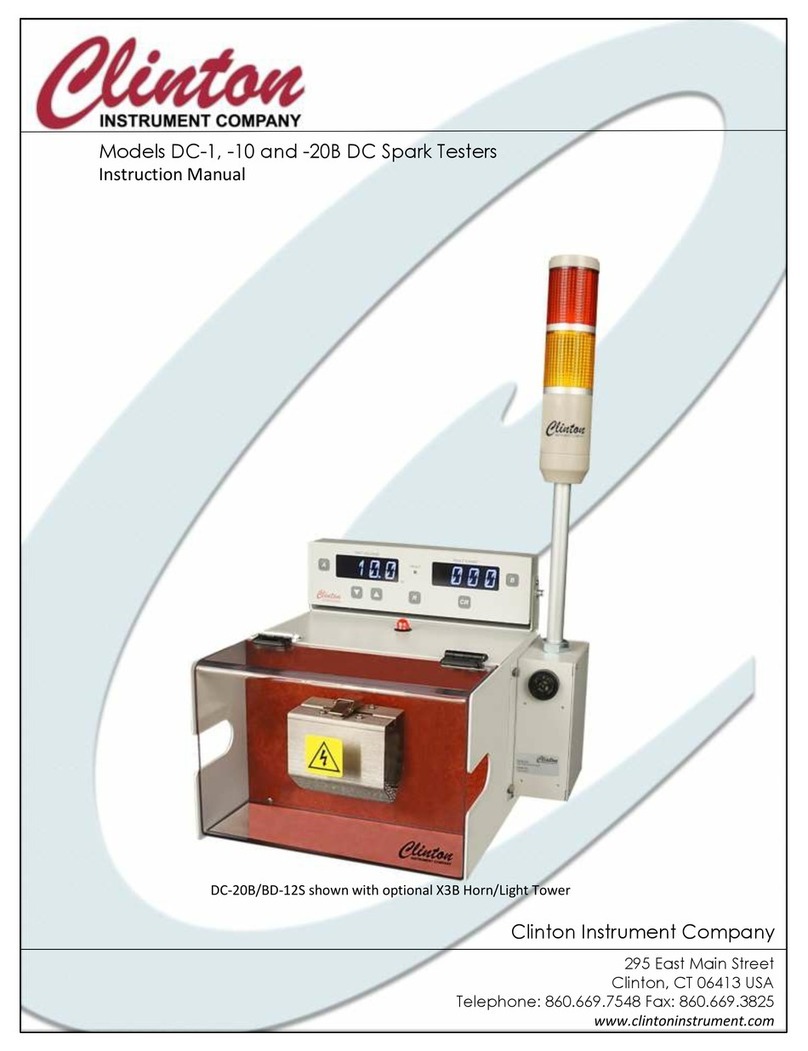MEGABRAS MTD-20KWe User manual

3
MTD-20KWe
Digital earth tester
User’s Guide
GU-1192
© 2006 MEGABRAS. All rights reserved.
Printed in Brazil

4
This page was left blank intentionally.

5
Index
1. Description______________________________________________________6
2. Operating instructions _____________________________________________7
2.1. Panel controls________________________________________________7
2.2. Output Terminals ~___________________________________________8
2.3. Internal battery _______________________________________________8
2.4. Battery status check ~_________________________________________8
2.5. Power supply source ~________________________________________8
2.6. Battery charge________________________________________________9
2.7. Measurement ranges _________________________________________10
2.8. Grounding resistance measurement______________________________10
2.9. Spurious voltages measurement ________________________________11
2.10. Soil resistivity measurement –Wenner Method ____________________11
2.11. Audible Alarm ______________________________________________14
2.12. Influence of grounding resistance of the auxiliary rods_______________15
2.13. Special considerations about grounding resistance measurements_____15
3. Equipment operation checking______________________________________17
4. Technical Specifications __________________________________________19
5. Warranty ______________________________________________________21

6
1. Description
The MTD-20KWe digital earth tester allows for the measurement of Earth
Resistances and Soil Specific Resistivity, and also the spurious voltages
caused by parasitic voltages present in the soil.
This equipment is suitable for fast and easy measurement of the grounding
resistance in house and industrial buildings, hospital installations, lightning
rods, antennas, substations, etc. Soil resistivity measurement allows for soil
stratification in order to optimize the most complex grounding systems
engineering. Its state-of-the-art system of active and passive filters provides
it with high immunity to electric interferences, making it possible to obtain
reliable measurements even in the presence of spurious voltages, such as
the ones that can be found in some urban areas and near primary
substations.
It has an audible signal which advises the operator when the generated
current is not enough to carry out reliable measurements. Due to the fact
that it may not be noticed, this alarm also prevents further testing.
Because of its wide range of measurement (from 0.01 Ωup to 20 kΩ), this
equipment allows for reliable testing in all kinds of soils, including those that
offer very high resistivity. The use of this instrument is very simple, it has a
high-visibility 3½ -digit display with direct readings, even under sunlight.
This earth tester is supplied with a rechargeable internal battery. The smart
charger is microprocessor-controlled, and can be powered from a 12 V car
battery (or a similar one).
It has a sturdy, easy and safe to carry cabinet, with IP54 protection level. It
is suitable to work under adverse geographical and environmental
conditions, with extreme temperatures in cold or tropical regions and in high
mountain areas, showing a reliable performance in the field.

7
2. Operating instructions
2.1. Panel controls
!
"
#
$
%
&
'
(
)
*
+
!-3½ digits display
"-Battery Charger Status LED
#-Output Terminal H (EC)
$-Output Terminal S (ET)
%-Output Terminal ES (EXT)
&-Output Terminal E (EXC)
'-START (Pushbutton)
(-FUNCTION SELECTOR (Rotary Switch)
R (3 poles) = Grounding Resistance
V = AC Voltmeter
ρ(4 poles) = Resistivity (4 rods)
)-DC Power Input
*-RANGE SELECTOR (Rotary Switch)
+-BATTERY TEST (Pushbutton)

8
2.2. Output Terminals ~
Green E (EXC) Terminal –Earth Electrode
Black ES (EXT) Terminal –Voltage Electrode
Blue S (ET) Terminal –Voltage Electrode
Red H (EC) Terminal –Current Injection
E -ES -S -H: Standard nomenclature currently recommended by the IEC.
EXC -EXT -ET-EC:Nomenclature traditionally used by Megabras earth
meters. It is maintained to make migration easy.
Having the function selector switch in the R position (grounding resistance
measurement) the E and ES terminals are internally shorted. The ES
terminal is not used for this measurement.
2.3. Internal battery
The MTD-20KWe has a built-in rechargeable battery. Furthermore, it can be
powered by means of an external 12 V battery.
2.4. Battery status check ~
Before starting each test, it is recommended to check if the internal battery
has enough charge. This can be done by pressing the Battery Test
Pushbutton+. The value shown on the display must be higher than
1000. If it is not, the battery needs to be charged. This checking can be
repeated during measurements, under the equipment highest consumption
conditions.
2.5. Power supply source ~
The power supply source provided can be connected to 220-240 V~ mains.
It is used to charge the battery.

9
2.6. Battery charge
This equipment has an internal battery charger with a smart,
microprocessor-controlled circuit which adjusts the battery charge to the
optimized parameters to ensure the maximum service life. It is supplied by
an external source for 220-240 V∼(supplied with the equipment) or by a
12 V car battery.
In order to recharge the battery, connect the equipment to the mains supply
or to the external battery. After a few seconds, the BATTERY CHARGER
STATUS LED"will flash during one second in green and red alternately.
During this period, the charger checks the battery initial status, selecting in
this way the charge optimized parameters. After this, the BATTERY
CHARGER STATUS LED"will remain lit in red until the charge is
complete, then the led will turn into green and will remain this way until the
equipment is disconnected from supply.
If, during the battery charge with 12 V car battery, the equipment is used to
perform measurements, the charge will be momentarily interrupted,
returning to the charge process once measurements are finished. In the
following table we summarised the meaning of the luminous indications of
the LED"
Alternate green and red lights
Evaluation of the battery initial status when the
source is connected, during one second.
Steady red light Battery under charge.
Flashing red light The battery was not successfully charged. It de
notes
some trouble in the battery charging process.
Steady green light The charge has successfully finished. The battery is
OK.
Note: Under storage, the battery loses part of its charge. Thus, before using the
equipment for the first time, or after some time of being out of use, the battery must
be recharged. As the kind of rechargeable battery that this equipment uses does not
show the “memory effect” and due to the charger intelligent characteristics, there are
no restrictions to start charging it as many times as is needed. As soon as the
charger detects that the battery is completely charged, it will automatically turn to the
Float state (Green indication), protecting it from overcharging.

10
2.7. Measurement ranges
The equipment has 4 resistance measurement ranges:
Range Unit Reading resolution
0 –20.00 Ω0,01
0 –200.0 Ω0,1
0 –2000 Ω1
0 –20 kΩ0,01
2.8. Grounding resistance measurement
1. Insert in the soil the two auxiliary rods: the E3 current rod and the E2
voltage rod. Connect them by means of provided cables to H(EC)#
and S(ET)$output terminals, respectively. The E(EXC)&terminal must
be connected to the grounding system under test (E1) using the 5
meters cable (see fig. 01).
E3 E2
E1
fig. 01
D1
D2
40m cable
20m cable 5m cable
Current
rod
Voltage
rod Ground
to be
measured
2. Select the R(3 pole) position in the FUNCTION Selector Switch(.
Select the 20 kΩ range with the RANGE Selector Switch*and press
the START Pushbutton'. If the resistance value is lower than 2kΩ,
select the most adequate, electing the scale from the highest to the
lower. If the acoustic alarm bips, this indicates some abnormality in the
rods wiring, the reason may be a misconnection or an excessively high
diffusion resistance in the current rod. Check the installation to fix this
problem. (See item 5).

11
If a number 1 appears in the most significant digit position, this means
that the measured value is higher than the highest one of the selected
range (Overrange). In this case, the immediately higher range must be
selected until finding a valid reading value (this will not be possible if
the measured resistance is higher than 20 kΩ).
2.9. Spurious voltages measurement
1. In order to check the existence and to measure the spurious voltages
present in the soil, the inserted rods must be kept in place, connected
to the equipment as shown in figure 01.
2. Select the V position with the FUNCTION Selector Switch(and
press the START Push-button'. The display will show the AC
voltage between the grounding E1 and the E2 probe, up to 200 V.
2.10. Soil resistivity measurement -Wenner Method
1. Insert four rods (spikes) in the soil, well aligned and with a constant D
separation, as shown in fig. 02. When performing this measurement,
the distance between the rods is critical as it takes part in the
resistance calculation.
2. Select the position ρ(4 pole) in the FUNCTION Selector Switch (
and connect the rods, as it is shown in figure 02.
fig. 02
D
H(E)
C
S(E)
T
ES(E)
XT
E(E)
XC
D
D

12
3. Find the most appropriate range and press the START Pushbutton'.
4. To obtain the soil resistivity value, Wenner’s equation should be
applied. In its simplified form, this equation is as follows:
ρ= 2πR D
Where:
•ρ= soil resistivity value, expressed in [Ωm]
•π= 3.14159
•R= value shown on the display.
•D= distance between the rods, expressed in meters.
In this way, mean soil resistivity is obtained from the surface up to a
depth equal to the D distance between the rods. The information
required to determine the soil stratification by means of a graphic
method or by the use of an appropriate software is obtained by
performing several measurements with different distances between the
rods. The distances which are generally adopted are: 1m, 2m, 4m, 8m,
16 m. In order to carry out measurements with D=16m, cables can be
distributed as shown in figure 03, with the instrument near the ES rod.
D
H(E)
C
S(E)
T
ES(E)
XT
E(E)
XC
D
D
p
40m cable
5m cable
fig. 03
20m cable
20m cable

13
5. Wenner’s equation simplified form can be applied whenever the
insertion depth of each rod is not significant compared to the D
distance. This condition can be difficult to fulfil when D is small, due to
the need of ensuring a good contact between the rod and the soil. If
this were the case, the full form of the equation must be applied:
=
4 RD
2D
D+ 4 p
2 2
D
1 +
-
D+ p
2 2
Where:
ρ= soil resistivity [Ωm]
D = distance (spacing) between rods [m]
p = insertion depth of the auxiliary rods [m]
R = value shown on the display
When D >> p, the simplified form is obtained.
6. In order to properly evaluate soil resistivity, measurements must cover
the whole area to be occupied and influenced by the future grounding
system. For an area of up to 10,000 m2, it is recommended resistance
measurements to be performed in at least five points, arranged as
shown in figure 04. Two sets of measurements should be needed for
the central point (each set of measurements with its corresponding
spaces between rods of 1, 2, 4, 8 and 16 m).
Larger areas can be divided in areas of 10,000 m2each, and
measurements in 5 points can be carried out as shown in figure 04.
Besides, in the case of different forms, there will always be the
possibility of limiting a rectangle and proceed as in the previous case.

14
a
ba/4 D
a/2
b/2
b/4
a/4
B
E
A
b/4
C
Measurements points: A, B, C, D & E
Direction of measurements: x & y
yx
fig. 04
2.11. Audible Alarm
The MTD-20KWe has an audible alarm circuit to avoid false measurement
records. If, due to any reason, the current is lower than the value required to
perform reliable measurements, or if there is no current flowing between
H(Ec) and E(Exc), the alarm circuit will be activated and will emit an audible
intermittent signal. When the operator is in the field during measurement
and hears the intermittent "beep" sound, he must check the connections to
the rods and to the earth tester terminals, as well as the wires continuity
(possibly, a wire may be cut off). If there isn’t any abnormality in the
connection or in the wires, it is possible that the soil resistance is
abnormally high, causing an excessively high diffusion resistance of the
auxiliary rods. That resistance could be improved by watering the auxiliary
rods, or by inserting several interconnected rods. The battery status must
also be checked.

15
2.12. Influence of grounding resistance of the
auxiliary rods
Whenever the probe grounding resistance is lower than 1,000 Ω, the error
caused is not significant (less than 5%). The current rod may have a
resistance of up to 5,000 Ω, without affecting measurements and without
causing significant errors.
2.13. Special considerations about grounding
resistance measurements
By employing the Fall of Potential method, normally used to measure
Grounding Diffusion System (GDS) resistance, two rods are used as
auxiliary electrodes. In figure 01, D1is the distance between GDS E1and
the E3 current electrode, whereas D2is the distance between GDS and the
E2 probe. The current generated by the equipment flows through GDS and
the current electrode, and the voltage between GDS and the E2probe is
measured. The R value is obtained as the quotient between the voltage and
the current.
In figure 05 the potential profile has been graphically shown relating the
GDS in the area between this and the current electrode, assuming that the
distance between those points is enough for its corresponding “influence
areas” not to be overlapped. An “influence area” is the area close to each
electrode where a significant potential gradient is observed. Out of that
area, the potential is constant (potential plateau between points A and B -
Fig 05).
In order to obtain a valid measurement of the GDS resistances, it is
necessary to move the auxiliary current rod away enough to comply with the
“no overlap condition” of the areas of influence, and the voltage rod (probe)
must be set up in the potential plateau area. The criteria commonly
accepted is to consider that the radius of each influence area is three to five
times bigger than the electrode dimension.

16
The appropriate compliance of this condition must be checked by carrying
out three successive measurements of GDS resistances, keeping the
current rod position but moving the voltage rod about 2 meters between
measurements (points L, M, y N). If the three measurements show the
same result (within the earth meter specified error) the measurement should
be considered correct. Otherwise, the distance to the current rod should be
significantly increased and the process, repeated.
Potential plateau
R
A
L
M
N
B
fig. 05
Voltage Rod E2
measurements
points
Current Rod E3
influence area
Ground
diffusion
resistance
Current
Rod E3
Ground diffusion
resistance influence
area
Generally, GDS dimensions are greater than those of the auxiliary current
rod, thus its area of influence diameter is also greater. So, in order to
comply with the required condition, the probe must be set up closer to the
current rod than to the GDS. A distance of 62% is usually adopted as a first
try (62% rule). It should be noted that when measuring GDS resistances in
large systems (such as a large grid that underlies a substation) distances of
hundreds of meters are required to fulfil the condition. Technical literature
describes alternative methods that make it possible to reduce those
distances with valid results, such the “slope method” developed by Dr. G.
Tagg in 1970.
All these considerations refer to physical aspects, essential to the
measurement process, thus they are applied to all earth meters, and do not
depend on the manufacturer or the technology used.

17
3. Equipment operation checking
Using a standard resistance (i.e. 10.0 Ωnominal), it’s possible to test the
equipment calibration. This resistance must be connected to the 4 terminals
on the earth meter, as shown in figure 06.
fig. 06
RX
Following this procedure:
•The Function Selector Switch (must be in the ρposition (4 pole).
•The Range Selector Switch*must select the 20.00 Ωscale.
•Start the equipment.
•Press the Battery Test Button+to check the battery charge status. If
the display shows a value lower than 1000, the battery should be
recharged or external power supply should be used.
•Press the Start Pushbutton '. After 5 seconds, the display should
indicate a stable value, close to the nominal value of the standard
resistance.
•If this were not the case, the accuracy of the instrument would be out of
its specification and it would be necessary to adjust by a qualified
laboratory.
•If you want to calibrate the earth meter in other points of the present
range or of other ranges, adequate standard resistances must be used.
In order to avoid errors by the test leads resistances and their
connections, the 4-wire connection is used (fig 06), with the earth meter
in its measurement function of ρ(4 pole). According to the scale, the
highest acceptable error is:
Range Maximum error allowed
0 –20.00 kΩ±(2% of the measured value + 0.2 kΩ)
0 –2000 Ω±(2% of the measured value + 20 Ω)
0 –200 Ω±(2% of the measured value + 2 Ω)
0 –20 Ω±(2% of the measured value + 0.2 Ω)

18
When using a test resistance higher than 100 Ω, the leads and contacts
resistances are not significant, thus figure 07 configuration can be used,
with the Function Selector Switch (in the R position (3 pole).
fig. 07
RX
AB

19
4. Technical Specifications
Application :
Measurement of grounding resistances (3
terminals), soil resistivity (4 terminals) and spurious
voltages present in the soil.
Resistance
measurement method :
The equipment
injects an electronically stabilised
current in the soil, and measures, with high
preci
sion, the voltage developed in the soil by
means of that current flowing through grounding
diffusion re
sistances. Display shows the Resistance
value.
Immunity to interference :
Operation frequency: 1470 Hz
This operation frequency complies with the
equation:
Where:
fg = frequency of the current generated by the earth
meter.
n = integer number.
fi = industrial frequency (50 or 60 Hz)
The compliance with this equation implies that the
operation frequency will not coincide with any
harmonic of the industrial frequency, in order to
minimise the effect of parasitic currents present in
the surveyed soils, by means of the use of
appropriate filters.
Operation as a voltmeter :
In the voltmeter function, the equipment operates
as a CA conventional voltmeter, making it possi
ble
to check the presence and to measure volt
ages
generated by parasitic currents.
Measurement ranges :
Resistances: 0-20Ω; 0-200Ω; 0-2000Ωand 0-20kΩ
Voltage: 0-200V∼
Accuracy :
Resistances measurements
: ± (2% of the
measured value + 1% of the maximum value of the
selected range).
Voltage measurement
: ± (2% of the measured
value + 1% of end of scale value)
Reading resolution :
0.01Ωin the resistance measurement.
0.1V in the voltage measurement.

20
Output power and Current :
The output power is less than 0.5W, and the output
current is limited to less than 15mA (Peak to peak)
Battery status checking :
It makes it possible to verify the battery charge
status under normal use conditions.
Audible alarm :
It warns the operator in case that there are
ab
normalities in the current circuit, which make it
difficult to obtain a reliable result.
Power supply :
By means of an internal rechargeable battery or
from a 12 V external battery.
Battery charger :
It is supplied by means of an external power supply
for 220-240 V∼
(provided with the equipment) or
from a 12 V car battery.
Operation temperature :
-10°C to 50°C
Storage temperature :
-25°C to 65°C
Humidity :
95% RH (without condensation)
Equipment weight :
Approximately 2.4 kg (without accessories)
Dimensions :
221 x 189 x 99 mm.
Included accessories :
•Four steel rods.
•Connection wire to supply the charger with a 12
V
external battery (the car battery).
•Battery charger power supply, 220-240 V∼input
voltage.
•One 40 meters cable in red colour.
•Two 20 meters cable in blue and green colour.
•One 5 meters cable in black colour.
•One 5 meters cable to connect to the grounding
system to be measured.
•Canvas bag.
This User’s guide.

21
5. Warranty
MEGABRAS INDÚSTRIA ELETRÔNICA LTDA. (“MEGABRAS”) warrants
to the original purchaser that each equipment it manufactures will be free
from defects in material and workmanship under normal use and service.
The warranty period is valid for 24 months, except for the built-in
rechargeable battery that has 06 months, and begins on the date of
shipment. The manufacturer's warranty does not apply to any product or
accessories which, in the manufacturer's opinion, has been misused,
altered, neglected, or damaged by accident or abnormal conditions of
operation and handling.
To obtain warranty service, send the equipment, with a description of the
difficult, shipping and insurance prepaid, to MEGABRAS. The manufacturer
assumes no risk for damage in transit. MEGABRAS will, at its option, repair
or replace the defective equipment free of charge or refund your purchase
price. However, if MEGABRAS determines that the failure was caused by
misuse, alteration, accident or abnormal condition or handling, you will be
charged for the repair and the repaired equipment will be returned to you
transportation prepaid.
This warranty is exclusive and is instead of all other warranties, express or
implied, including but not limited to any implied warranty or merchantability
or fitness for a particular purpose or use. MEGABRAS will not be
responsible for any special, indirect, incidental, or consequential damages
or loss of data, whether in contract, or otherwise.
For application or operation assistance or information on MEGABRAS
products, contact:
MEGABRAS INDÚSTRIA ELETRÔNICA LTDA
R. Gibraltar, 172 -São Paulo -Brazil
fax: (+ 55 11) 5641-8111 -
email: [email protected]

22
Notes
Table of contents
Languages:
Other MEGABRAS Test Equipment manuals

